
Julie Oddo
Learn to Win Chief Customer Officer
We hear it all the time: “There’s never enough time for training.”
But today, training is more important than ever. Organizations are changing at an ever-increasing rate. We need to adopt new technologies, launch new products, and adapt to competitor moves faster and faster. It’s hard for employees to keep up!
80% of CEOs say that the need for new skills is their biggest business challenge. Employees constantly have to learn new concepts, technologies, and skills to do their jobs effectively. But according to Deloitte, the average employee only has 24 minutes per week available for learning.
You have precious little training time. So how can you make the most of it?
The key is focus. Our team believes that every minute of training should drive meaningful – and measurable – business impact.
By adopting this approach, teams can enjoy significant benefits, including:
- Improved business performance
- Increased learner engagement
- Lower rates of employee churn
- Concrete, quantified ROI of training
- Increased buy-in for training throughout the organization
It’s easiest to implement these focused learning cycles with training software like Learn to Win, but you can follow the process without any software. We’ve even created a free template that you can download and use to apply this process to your own business.
Step 1: Align on the metrics that matter
Before you dive into the training itself, the first step is to define the key stakeholders in your organization and empathize with what matters to them.
Who are the people who will ultimately assess the impact of your training efforts? You might want to consider the leaders of your business unit, your learners’ direct managers, or even your CEO.
Write down these people’s names. It helps to have specific stakeholders in mind as you go through this process.
Then, ask yourself, “What business results are most important for these individuals? What KPIs do they use to measure success?” Get as specific as possible.
Then, zoom out one level. Ask yourself, “As an organization, what business objectives are we trying to achieve in the next 6-12 months?”
Look for the strategic priorities your CEO or other leaders have articulated in company-wide emails or presentations. If you’re uncertain, ask your manager or other members of your team.
Write down these business objectives (feel free to use our template). Make sure they’re specific and concrete, and try not to include more than 3.
You’ll refer to this information in future steps. Together, this list of objectives will become your training North Star – the rubric that you’ll use to measure the impact of your training efforts.
Step 2: Define the learner competencies that drive job performance
Next, shift your focus to your learners.
In this step, you’ll brainstorm a list of all the things your learners need to know in order to do their jobs effectively. These are the learner competencies that drive performance.
Orient yourself around the business outcomes you identified in Step 1. Now, ask yourself, “What are the specific things that my learners need to be able to do in their jobs?”
Every company has unique operational knowledge that new team members need to learn quickly. However, our experience has shown that there are common categories of critical knowledge, even across industries as different as pharmaceuticals, freight & logistics, and hospitality.
To kick-start your brainstorming, we’ve listed some common categories below, along with examples from a hypothetical sales team.
- Industry and market knowledge. What do new hires need to know about our industry in order to sound credible and build trust in customer-facing interactions? What do team members need to know about our competitive landscape?
- Product knowledge. What are the differentiating features of your specific products, and what’s the best way for your reps to position them? What are the most frequent questions and objections that your customers raise, and what is the best way for reps to respond?
- Process knowledge. What’s our specific procedure for qualifying a prospect? What discovery questions must every rep ask, and in what order? How should reps implement our specific playbook to optimize pricing?
- Systems and technology. How is our implementation of Salesforce set up? What tech tools do we expect team members to use, and what do they need to know to get value from those investments?
- Critical compliance topics. What specific legal or safety policies do we want to have total confidence that reps understand and follow?
Our template includes a large blank space to brainstorm this list. Take full advantage of that space! Don’t edit down your list just yet. The next step is to prioritize this list, but for now, cast a wide net.
One more tip: Resist the temptation to reference your existing training content to create this list. We find that a blank sheet of paper or a whiteboard is the best way to get your creative juices flowing.
Once you’ve finished creating your initial list, you can always compare it to your existing training and add any competencies you may have missed in the first pass.
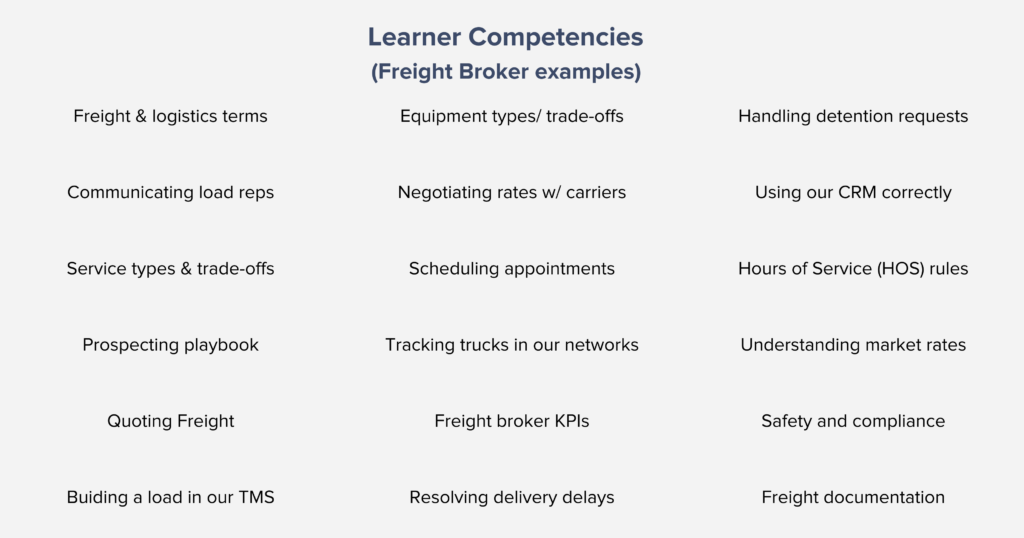
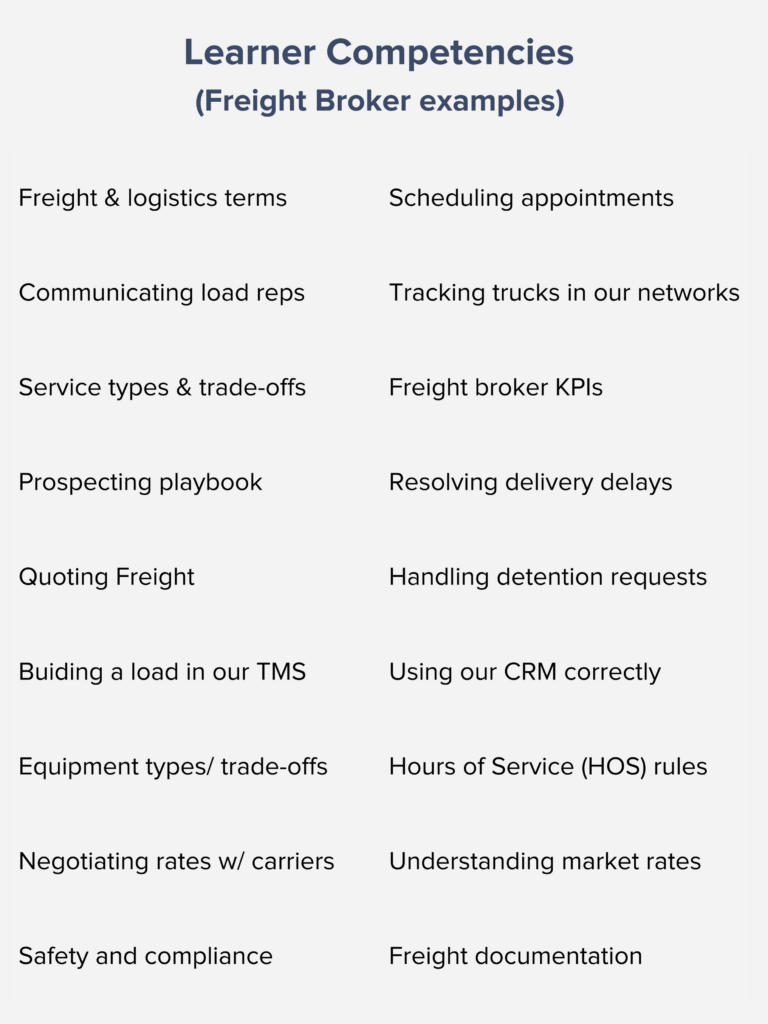
Step 3: Prioritize based on business impact
When we work with customers, we guide them through a structured process to prioritize their training needs. We’ve outlined those steps below, so you can run through the same process yourself. The screenshots below are from our template, which you can download here and adapt for your own organization.
Cost of Error Calculator
Unlock the potential of precise decision-making by understanding the true cost of errors in your organization – get your hands on our Cost of Error Calculator now.
PHASE 1
Start with the list of critical Learner Competencies that you brainstormed earlier.
PHASE 2
For each competency that you identified, ask yourself: “What mistakes are we trying to avoid?”
In other words, if your learners don’t understand this topic, how might it show up in their jobs?”
This question makes the business impact of training more concrete. It also helps us zero in on the information that is most relevant for your learners – and thus most important for them to master.
PHASE 3
For each mistake you identified, ask yourself: “What’s a story of how that mistake has appeared recently?”
Stories are sticky. They’re concrete and memorable for your learners. And they’re the bridges that connect your learning outcomes to business impact.
If you can’t think of a story of a recent mistake on the topic you identified, it’s fine to construct a hypothetical scenario. However, this might be a hint that you should consider prioritizing other mistakes that have caused real-world issues recently!
PHASE 4
Assess the relative dollar impact of each mistake that you identified.
Imagine a scenario where the mistake occurs. How serious would the business impact of that mistake be? Use a scale from 1-10 (where 1 = “not serious,” and 10 = “extremely serious”).
When making your assessment, be sure to consider 3 types of costs:
- Hard costs: Easy to measure in dollars and cents.
- Soft costs: Measured in time, reputation, and damage to the customer experience.
- Opportunity costs: Measured in lost future business.
PHASE 5
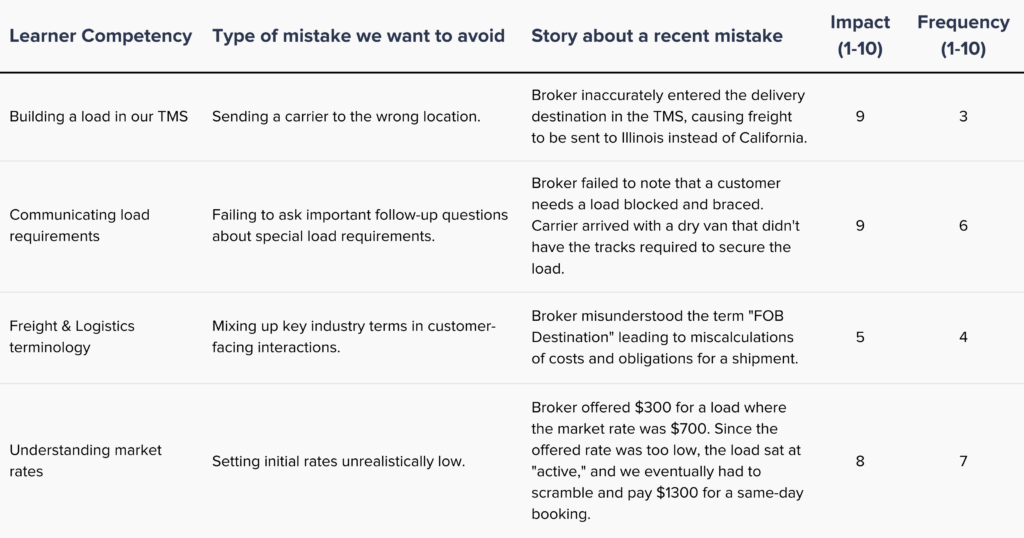
PHASE 6
Plot your impact and frequency assessments on a scatter plot to visualize the relative business impact of the mistakes you identified. Our free template will take care of this automatically for you.
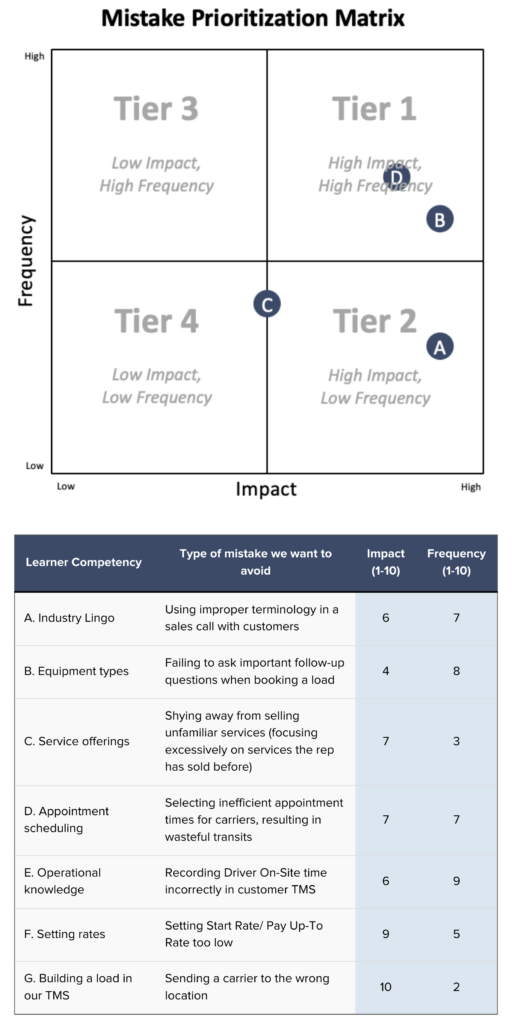
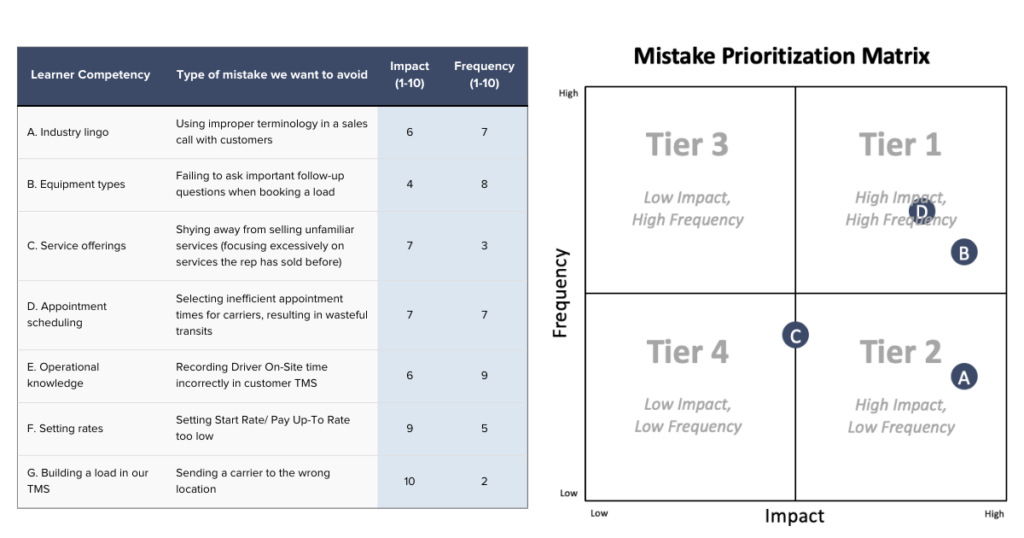
Based on your estimates, the mistakes you identified will fall into 1 of 4 tiers:
Tier 1: High Impact, High Frequency
These are the highest-priority mistakes to address. These mistakes have significant business impact each time they occur – and they’re widespread throughout your organization. If you focus on these issues first, you’ll likely drive immediate – and highly visible – business impact.
Tier 2: High Impact, Low Frequency
While these mistakes may occur infrequently in your organization, you may want to prioritize them if the cost of the mistake is high enough. For instance, some errors pose extremely high legal, compliance, or reputation risks.
Tier 3: Low Impact, High Frequency
While a single mistake in this category is unlikely to cause huge problems for your company, the fact that the error is widespread should be cause for concern. These items may not be urgent enough to address first; however, if you can drive down the frequency of mistakes, you will likely see medium-to-long term improvement in business metrics.
Tier 4: Low Impact, Low Frequency
This is training that you can confidently deprioritize, as knowledge gains are unlikely to drive measurable business results.
Step 4: Rebalance your training portfolio
Now that you’re equipped with a framework that identifies which knowledge gaps have the biggest impact on your learners’ job performance, take stock of your existing training material. Does the majority of your current training content map to Tier 1 topics (high impact, high frequency)?
If it doesn’t, then you have a significant opportunity to improve the ROI of your training. We recommend building focused microlearning modules that target the most urgent knowledge gaps on your team.
Moving beyond Tier 1 and Tier 2 training topics, we’ve found that many of our customers have large volumes of training that address Tier 3 and Tier 4 training topics.
The challenge with this content? It can feel generic for learners, so they often dismiss it as “not relevant” to what they need to know to do their jobs. In these cases, you can often make small adjustments that significantly improve the value of this training.
In many cases, the information your learners most need to know is hard to find. It might be buried in a binder, old PowerPoints, or PDF documents. If you just extract that critical content and get straight to the point, you can focus your learners’ precious training time on content that will accelerate your business.
What about content that doesn’t clearly map to a high-impact or high-frequency operational error? You may want to consider deprioritizing these topics for now, as they’re unlikely to deliver a high ROI on your training investment.
Step 5: Win over your learners
Now that you’ve done the hard work of focusing your training investment on your most urgent business needs, how do you persuade your learners to actually engage with your content? We recommend 3 best practices:
- Show respect for your learners’ time. In your communication with learners, make it clear that you understand how busy they are. Explain that your objective is to help them do their jobs better and more easily, and that you’re committed to only providing relevant, timely, and impactful training.
- Focus on ”What’s in it for me?” (WIIFM). Make the case for your training from your learner’s perspective. This is where the stories that you captured in Step 3 will come in handy. Paint a vivid picture of the mistakes your training will help them avoid. When your learners empathize with these horror stories, they’ll be highly motivated to avoid a similar fate!
- Use data. One reason learners tune out is because they assume they already know what you’re teaching. We’ve found that one of the most useful strategies is to conduct a quick pre-training assessment. At Learn to Win, we like to incorporate a Confidence Check feature to show learners where they are “Confidently Wrong.” By pointing out this knowledge gap, you can trigger a hunger to learn among your learners.
Step 6: Measure your impact
Once you’ve completed the training, measure the results. Pre- and post-training assessment data is the simplest way to quantify learner growth that took place as a result of your training. But thanks to the process you just followed, you can take this insight a few steps further.
Since you previously identified the specific mistakes that you were building training to prevent, gather data about how frequently those incidents occurred after your training. Ideally, you can draw from operational or performance data, but if not, ask for qualitative feedback from your learners’ managers.
At this point, you’ve completed a single focused training cycle. You’ve connected every step of the process — and every minute of your training energy — to the business outcomes that matter for you, your learners, and your cross-functional stakeholders.
If you completed the Cost of Error calculation in Step 3, you’ll be able to quantify the dollar impact of this first cycle. This is a powerful way to build buy-in and enthusiasm for additional training investment in the future.
At this point, all you have to do is decide what’s next and repeat the cycle. Revisit the framework that you built (feel free to update it with any new information you learned from this process), and target the next highest-impact topic.
With each cycle, your training will become faster, more focused, and more effective. Your learners will love it, and you’ll feel confident in the business impacts of your hard work.
Download your copy of the Training Prioritization Template now!
Turn training time into a significant business game-changer. By using our Training Prioritization Template, you can unlock efficient, focused learning that drives measurable business impact.

